Are you stuck choosing the right ceiling fan for your home? With so many types of ceiling fans out there, it’s easy to feel lost. Ceiling fans can cut your energy bills by up to 14% in summer.
This guide will walk you through eight fan types to help you pick the perfect one. Ready to find your ideal fan?
Key Takeaways
Ceiling fans can cut energy bills by up to 14% in summer, with ENERGY STAR® models using 20-30% less power than standard fans.
Low-profile fans are ideal for rooms with ceilings 8 feet or less, while standard fans need at least 7 feet of clearance between the floor and blades.
Smart ceiling fans can be controlled by voice assistants like Google Assistant and Amazon Alexa, and can be integrated with smart home systems for automation.
Outdoor ceiling fans come in dry, damp, and wet ratings, with wet-rated fans able to withstand direct rain or snow.
Commercial ceiling fans are designed for large spaces, with some industrial models spanning up to 24 feet across and featuring high airflow rates measured in cubic feet per minute (CFM).
Table of Contents
Overview of Standard Ceiling Fans
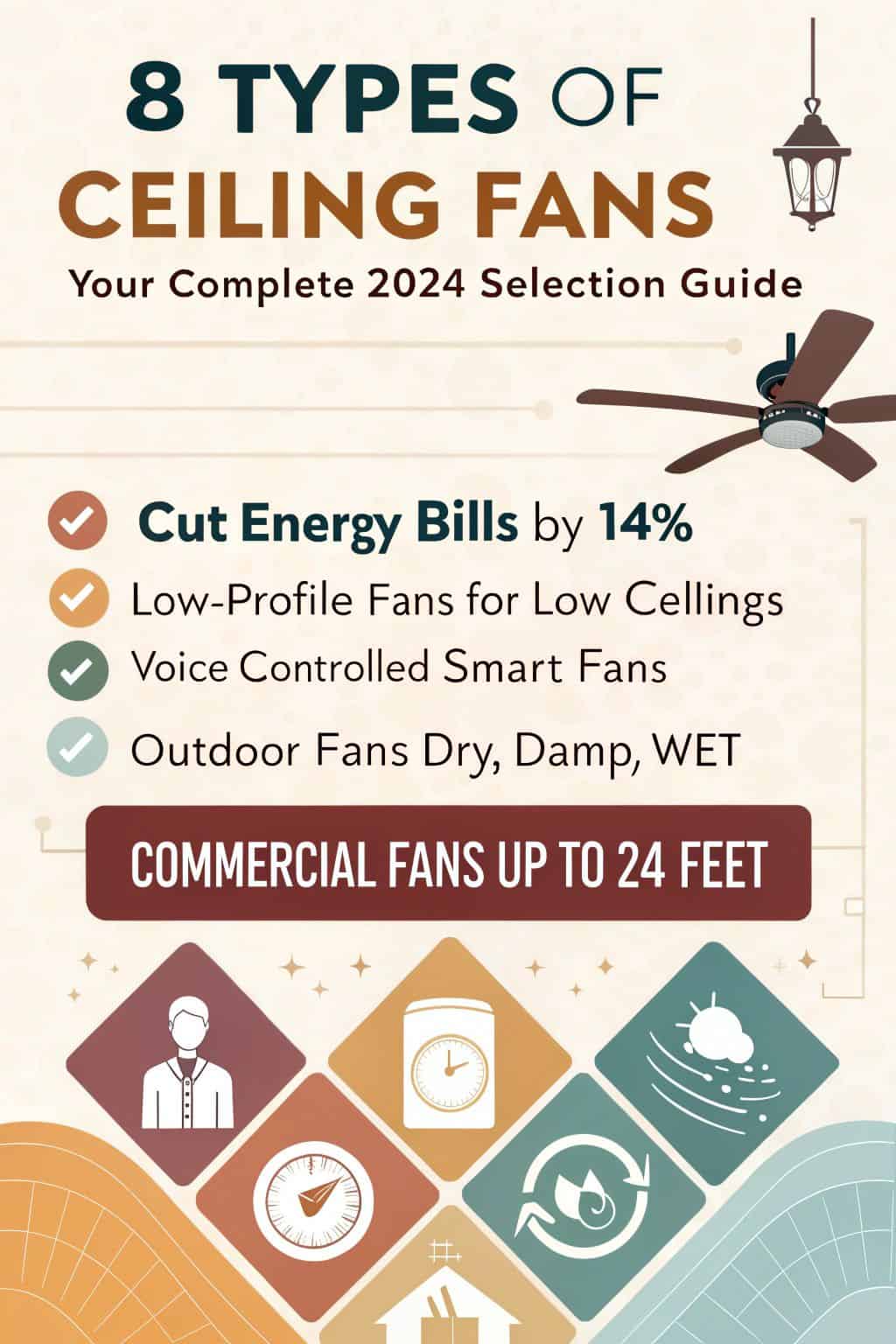
Standard ceiling fans are the workhorses of home cooling. They come in many styles and sizes to fit any room’s needs.
Key Features and Installation
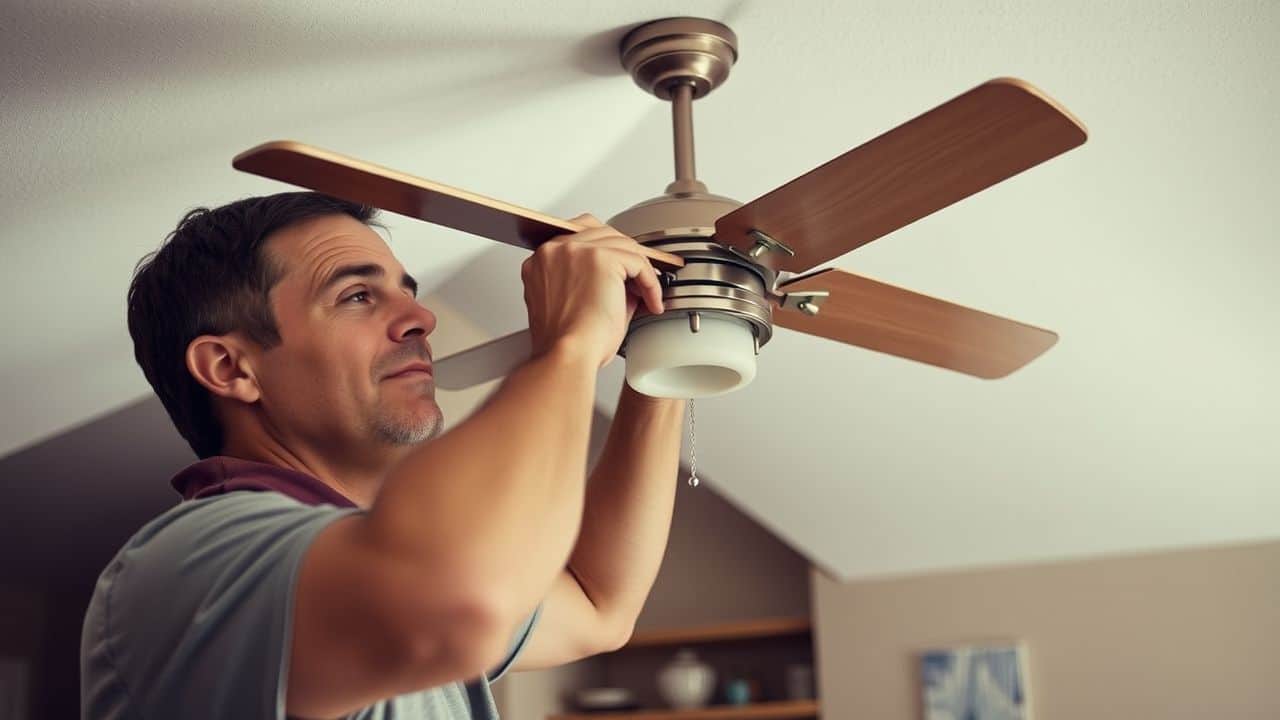
Standard ceiling fans offer a classic look and reliable performance. They come with several key features and installation tips to keep in mind:
- Blade count: Most standard fans have four or five blades. This design balances airflow and noise levels.
- Light kits: Many fans include or can be fitted with light fixtures. These add illumination to your room.
- Downrod mounting: Fans hang from the ceiling using a downrod. This helps maintain proper clearance from the floor.
- Ceiling compatibility: Standard fans work on both flat and sloped ceilings. Special mounting brackets may be needed for angled ceilings.
- Height requirements: For safety, fan blades should be at least seven feet above the ground. This prevents accidents and ensures good air circulation.
- Motor types: Fans use either AC (alternating current) or DC (direct current) motors. DC motors are often more energy-efficient.
- Controls: Options range from pull chains to wall switches and remote controls. Some even connect to smartphones for easy operation.
- Size considerations: Fan size should match your room size. Larger rooms need bigger fans for effective cooling.
- Energy efficiency: Look for ENERGY STAR rated fans. These use less power and can help lower your energy bills.
- Style options: From modern to windmill ceiling fans, there’s a design to match any decor.
Now, let’s explore the benefits of low-profile ceiling fans for rooms with lower ceilings.
Best Locations for Standard Ceiling Fans
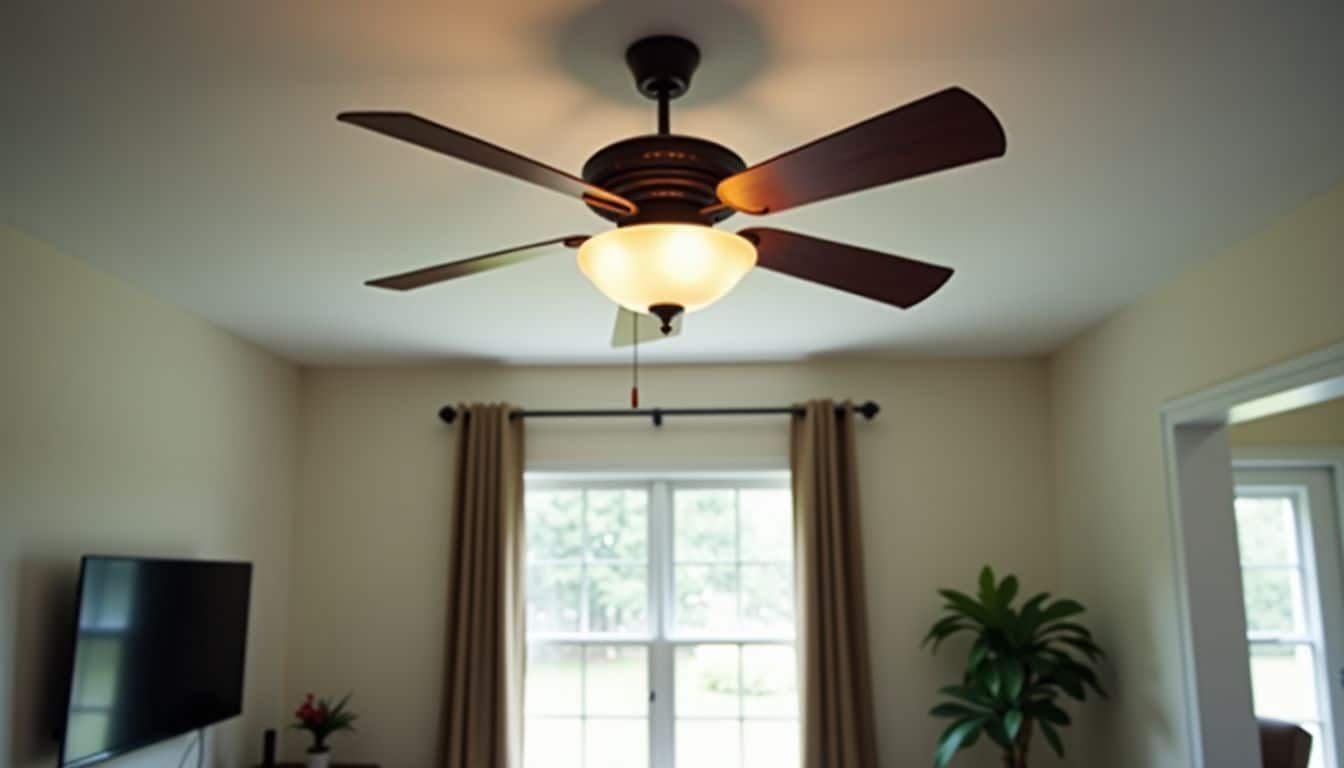
Standard ceiling fans work best in rooms with high ceilings. You’ll want at least 7 feet of clearance between the floor and the fan blades. Living rooms, bedrooms, and kitchens are ideal locations for these fans.
They perform well in spaces over 12 feet long, where a 48 to 56-inch blade span fits perfectly. These fans can transform stuffy rooms into cool, breezy havens.
For maximum comfort, place your fan in the center of the room. This allows air to flow evenly throughout the space. If you have an odd-shaped room, don’t worry. Just aim for the area where people gather most.
A well-placed fan can make even the hottest summer day more comfortable. These fans aren’t just for cooling – they can help warm rooms in winter too by pushing hot air down.
Benefits of Low-Profile Ceiling Fans
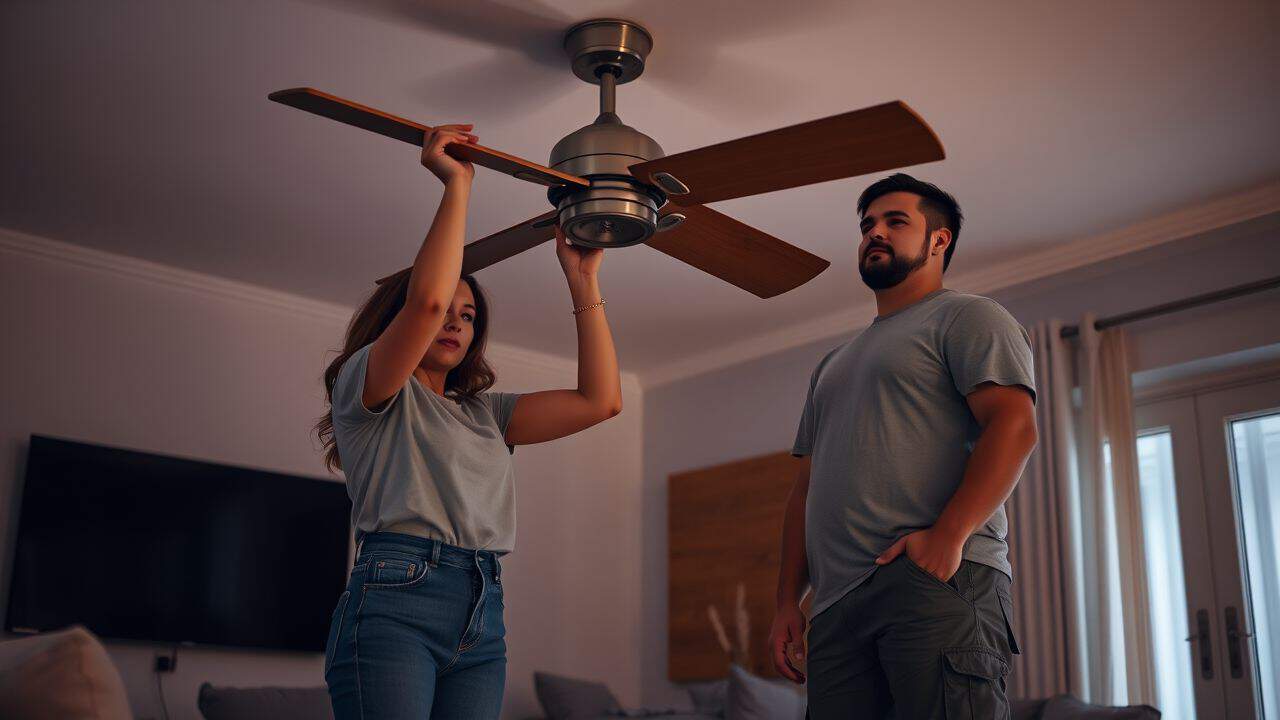
Low-profile ceiling fans are a game-changer for rooms with low ceilings. They hug the ceiling tightly, giving you more headroom and a sleek look.
Best Fit for Rooms with Low Ceilings
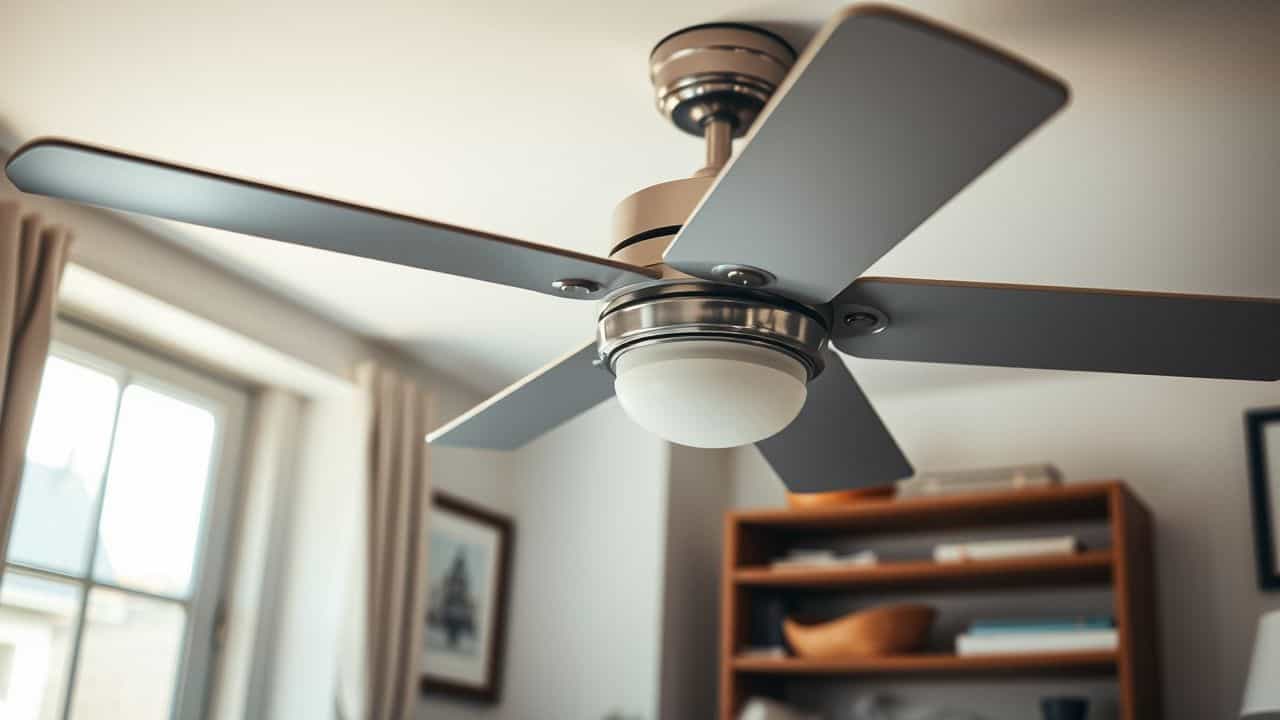
Low-profile ceiling fans are perfect for rooms with ceilings eight feet or less. These fans sit close to the ceiling, giving you more headroom. They’re also called hugger or flush mount fans.
You’ll find them great for small bedrooms, kitchens, or basements.
A low-profile fan can make a big difference in a small space.
I’ve installed these in my own home. They work well and look good too. Plus, they don’t bump your head when you walk under them. That’s a big plus for tall guys like me!
Tips for Installing Low-Profile Ceiling Fans
Now that you know where low-profile fans work best, let’s talk about putting them up. Installing these fans isn’t rocket science, but a few tips can make the job easier and safer.
- Check your ceiling height. Low-profile fans need at least 7.5 feet from floor to ceiling. This keeps the blades safely above your head.
- Turn off the power. Always cut the juice at the breaker box before you start. Safety first, guys!
- Use the right mounting bracket. Most low-profile fans come with their own. If not, get one made for your fan model.
- Balance is key. Make sure the fan is level when you hang it. A wobbly fan is annoying and can be dangerous.
- Tighten all screws. Double-check every connection. Loose parts can cause vibration and noise.
- Install a dimmer switch. This lets you control both fan speed and light brightness. It’s a cool feature that’s as effective as AC for comfort control.
- Consider a remote control. It’s not just lazy-man’s tech. Remotes are great for high ceilings or beds where you can’t reach the pull chain.
- Test before you celebrate. Once everything’s hooked up, turn the power back on and give it a spin. Check for any odd noises or movement.
Advantages of ENERGY STAR® Ceiling Fans
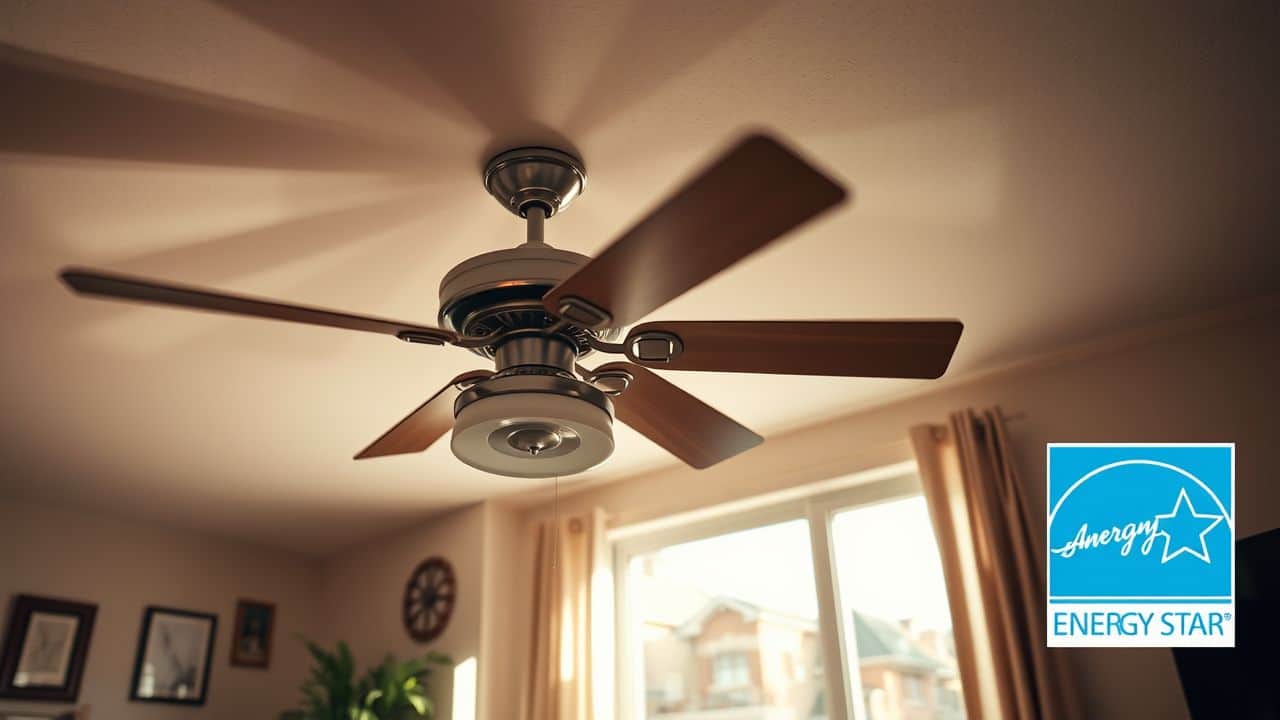
ENERGY STAR® ceiling fans are a smart choice for your home. They cut energy costs and keep you cool without breaking the bank.
Why Choose Energy Efficient Fans
Energy efficient fans are a smart choice for your home. They use 20-30% less power than standard models, which means lower electric bills. You’ll save 30-40% on cooling costs each month.
That’s money in your pocket and less strain on the power grid.
These fans also help the planet. They cut down on greenhouse gases by using less energy. It’s an easy way to make your home greener without giving up comfort. Plus, you get the same cool breeze and airflow as regular fans.
It’s a win-win for your wallet and the environment.
Energy-efficient fans: cool savings for your home and the Earth.
How to Spot ENERGY STAR® Certified Fans
Now that you know why energy-efficient fans are great, let’s talk about spotting ENERGY STAR® certified ones. These fans stand out from the crowd with some key features. Here’s how to spot them:
- Look for the blue ENERGY STAR® label. It’s usually on the fan’s box or product info.
- Check the fan’s energy use. ENERGY STAR® fans use 20-30% less power than regular ones.
- See if it has LED lights. Many certified fans come with energy-saving LED bulbs.
- Find out about the motor. ENERGY STAR® fans often have more efficient motors.
- Ask about the warranty. Certified fans typically have longer warranties.
- Compare the airflow. ENERGY STAR® fans move air better, measured in cubic feet per minute.
- Look at the fan’s size. Certified fans come in various sizes to fit different rooms.
- Check for smart features. Some ENERGY STAR® fans connect to smart home systems.
- Find out about the fan’s settings. Certified fans often have more speed options.
- Ask about rebates. Many power companies offer deals on ENERGY STAR® products.
Features of Dual-Motor Ceiling Fans

Dual-motor ceiling fans pack a punch with two separate motors. They offer more airflow and style options than standard fans.
Unique Design and Functionality
Dual-motor ceiling fans stand out from the crowd. They sport two fan heads on a single mount, each with its own motor. This setup allows for custom airflow in different parts of a room.
You can point one fan head toward your couch and another toward your dining area. It’s like having two fans in one!
These fans shine in big, open spaces. Think living rooms, great rooms, or even spacious bedrooms. The central motor lets you adjust each fan head separately. This means you can cool different spots at different speeds.
It’s a game-changer for rooms with hot and cold zones.
A dual-motor fan is like having a personal climate control system in your home.
Appropriate Settings for Dual-Motor Fans
Dual-motor fans shine in big rooms where you need lots of air moving. Think about your living room or a spacious bedroom. These fans pack a punch with two motors, giving you more control over airflow.
You can adjust each blade set separately, which is great for those hot summer days when you want a strong breeze.
I’ve used these fans in my own home, and they’re perfect for my open-plan kitchen and dining area. The extra power helps cool the whole space evenly. Plus, they look pretty cool spinning at different speeds.
If you’re into smart home stuff, some dual-motor fans even work with Google Home or Amazon Echo. That means you can control them with your voice or phone, making life a bit easier.
Exploring Smart Ceiling Fans

Smart ceiling fans bring cool tech to your home. You can control them with your phone or voice, making life easier.
Connectivity and Smart Features
Smart ceiling fans have come a long way. They now work with popular voice assistants like Google Assistant and Amazon Alexa. You can control these fans with your smartphone too. Just grab your phone and open the app to adjust fan speed or turn lights on and off.
It’s that easy.
These high-tech fans offer cool automation features. You can set schedules for your fan to turn on or off at certain times. This helps save energy and keeps your home comfy all day long.
Some smart fans even link up with your thermostat to adjust based on room temperature. Talk about smart!
Integrating Fans with Smart Home Systems
Now that we’ve covered smart features, let’s talk about making your fan play nice with your other gadgets. Integrating ceiling fans with smart home systems is easier than you might think. Here’s how to do it:
- Pick a compatible fan. Look for fans that work with popular systems like Apple HomeKit, Google Home, or Amazon Alexa.
- Check your Wi-Fi. Most smart fans need 2.4G Wi-Fi to connect. Make sure your home network supports this.
- Download the right app. Each brand usually has its own app for setup and control.
- Link to your smart hub. Use the app to connect your fan to your main smart home system.
- Set up voice control. Once linked, you can tell your fan what to do using Siri, Google Assistant, or Alexa.
- Create routines. Program your fan to turn on or off at certain times or when other things happen, like when you come home.
- Use IFTTT for more options. This service lets you create custom commands for your fan and other smart devices.
- Pair with smart thermostats. Some fans can work with devices like Nest or ecobee to help save energy.
- Add smart switches. These can control your fan even if it’s not “smart” on its own.
- Keep it updated. Check for firmware updates to get new features and fix bugs.
Guide to Outdoor Ceiling Fans
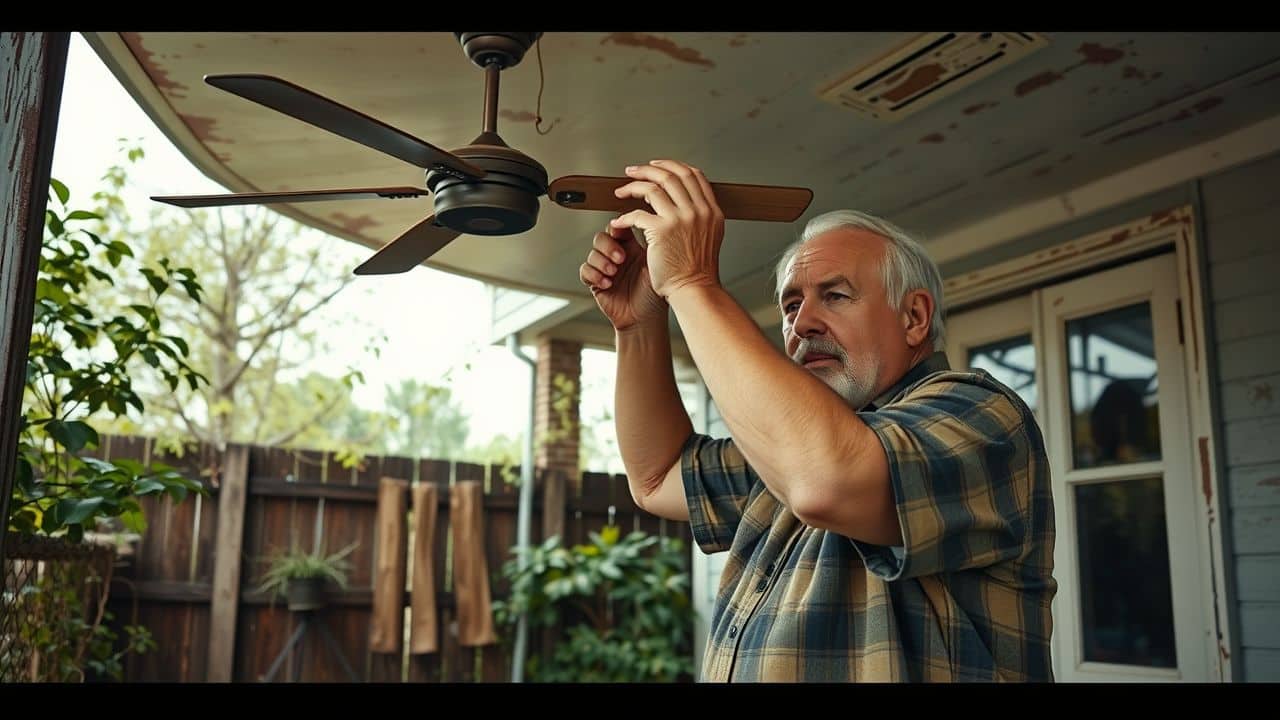
Outdoor ceiling fans are tough cookies. They brave rain, sun, and wind to keep your patio cool. Pick the right one, and you’ll have a backyard buddy for years to come.
Understanding Ratings: Dry, Damp, and Wet
Ceiling fan ratings tell you where to use your fan safely. Dry-rated fans work best indoors, away from moisture. Damp-rated fans can handle humid spots like covered patios or bathrooms.
Wet-rated fans are tough enough for direct rain or snow. They’re perfect for open decks or gazebos.
I once put a dry-rated fan on my covered porch. Big mistake! The humidity caused rusting within months. Now I know better. For outdoor spaces, always go with damp or wet ratings. Some brands even offer WeatherMax® tech for coastal areas.
This special coating fights off salt air and keeps your fan spinning smoothly for years.
Selecting Suitable Outdoor Ceiling Fans
Now that you know about ratings, let’s pick the right outdoor fan. Outdoor ceiling fans need to handle tough weather and look good doing it.
- Check the size: Measure your space. For patios, go for fans 52 inches or wider. Smaller porches might need 42-inch fans.
- Look at blade count: More blades move air slower but quieter. Fewer blades spin faster and push more air.
- Pick durable materials: Go for metal, plastic, or treated wood. These fight off rust and stand up to sun and rain.
- Choose the right style: Match your home’s look. Farmhouse fans fit rustic homes. Modern designs work for sleek spaces.
- Think about lighting: Many outdoor fans come with built-in lights. LED options save energy and last longer.
- Consider smart features: Some fans connect to your phone. Control speed and direction from anywhere.
- Don’t forget the motor: Bigger motors last longer in tough outdoor spots. They also move more air.
- Set a budget: Outdoor fans can cost $100 to $500+. Pricier fans often last longer and have more features.
- Check the warranty: Outdoor use can be hard on fans. A good warranty protects your buy.
- Plan for installation: Some outdoor fans need special mounts or downrods. Make sure you have the right setup.
Choosing Commercial Ceiling Fans

Commercial ceiling fans pack a punch in big spaces. They’re built tough to handle long hours and keep large areas cool.
Features Designed for Large Spaces
Commercial ceiling fans pack a punch in big spaces. They sport larger blades and stronger motors than your average home fan. These beasts move air like nobody’s business, with high airflow rates measured in cubic feet per minute (CFM).
Big rooms need big fans to keep the air moving and folks comfortable.
Safety comes first with these big boys. They must hang at least 7 feet off the ground to avoid bonking tall people on the head. Some industrial models, called HVLS fans, are perfect for warehouses and factories.
These giants can span up to 24 feet across! With the right fan, even the largest spaces can stay cool and comfy.
Commercial Use Considerations
Large spaces need powerful fans. Commercial settings have unique needs for ceiling fans.
- Heavy-duty motors: Commercial fans need strong motors for non-stop use. They must run for hours without overheating.
- Airflow rates: Look for fans with high CFM (cubic feet per minute) ratings. More CFM means better air movement in big rooms.
- Blade design: Wide, sturdy blades push more air. Some commercial fans have special shapes for max airflow.
- Speed options: Multiple speeds let you adjust airflow as needed. This helps save energy and keeps people comfy.
- Reversible settings: Fans should switch direction for winter and summer use. This helps with heating and cooling all year.
- Durability: Commercial fans face more wear and tear. Pick fans made with tough materials that won’t break easily.
- Easy upkeep: Regular cleaning is a must. Choose fans with parts that are simple to reach and wipe down.
- Safety features: Look for fans with secure mounts and safety cables. This prevents accidents in busy spaces.
- Noise levels: Quiet operation is key in work areas. Test fans for low noise before buying.
- Energy use: ENERGY STAR® fans can cut power bills. They’re great for businesses watching their bottom line.
Accessories for Ceiling Fans
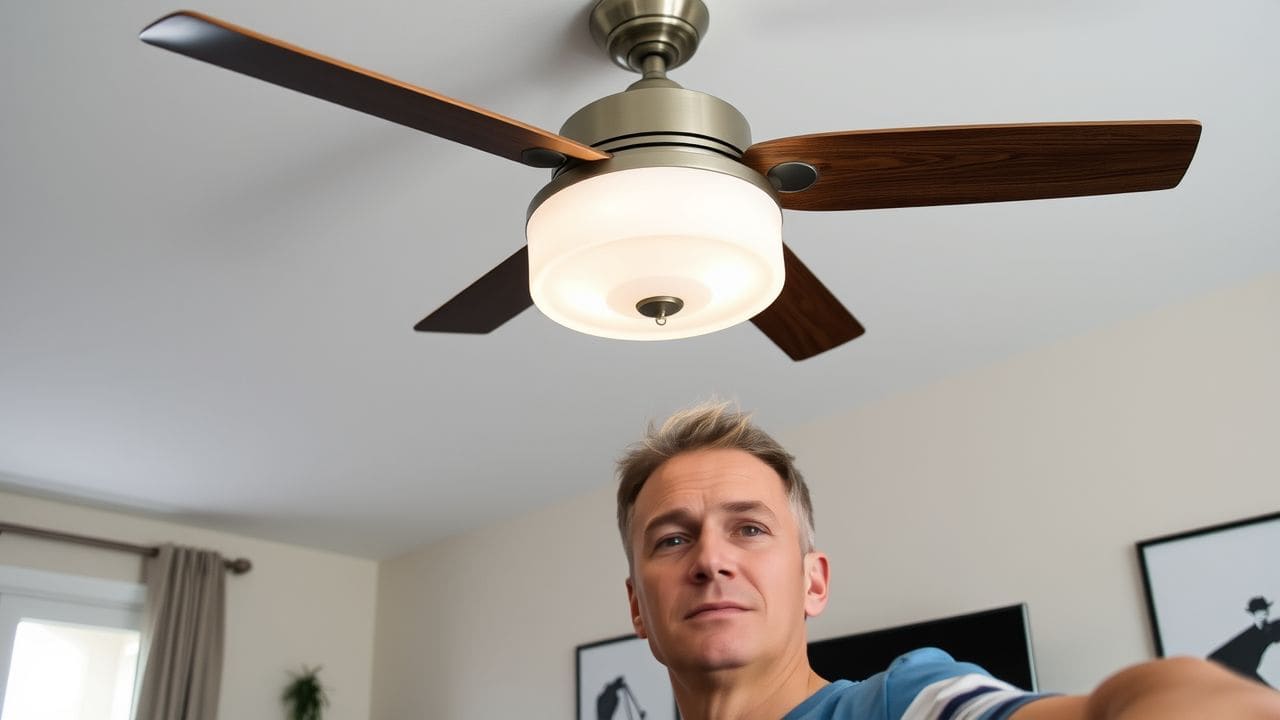
Ceiling fan add-ons can jazz up your room and boost your fan’s usefulness. Light kits and remote controls are just the start – there’s a whole world of cool gadgets to explore.
Options for Light Kits and Remote Controls
Ceiling fans offer more than just air movement. Light kits and remote controls can boost their usefulness and style.
- Light Kit Options:
- Bowl-style kits: These add a classic look and spread light evenly
- Branched kits: Perfect for extra brightness with multiple bulbs
- Sleek, modern kits: Ideal for a clean, up-to-date vibe
- Glass or fabric shades: Choose based on your room’s decor
- LED options: Save energy and last longer than standard bulbs
- Remote Control Features:
- Fan speed adjustment: Change airflow without getting up
- Light dimming: Set the mood with adjustable brightness
- Reverse function: Switch blade direction for winter use
- Timer settings: Auto-off feature for energy saving
- Wall-mounted options: Great for easy access and as a backup
- Color Choices:
- Black: Sleek and modern, works well in contemporary spaces
- White: Blends with most ceilings for a clean look
- Bronze/Brown: Adds warmth, suits rustic or traditional decor
- Brushed Nickel/Chrome: Offers a polished, upscale appearance
- Smart Integration:
- Wi-Fi enabled controls: Operate your fan from your phone
- Voice command compatibility: Use with Alexa or Google Home
- Scheduling features: Set your fan to turn on/off automatically
- Temperature sensors: Adjust fan speed based on room heat
- Installation Tips:
- Check weight capacity: Ensure your ceiling can support the added kit
- Wiring compatibility: Some older fans may need updates
- Height considerations: Low ceilings might need special kits
- Professional help: Complex installs may require an electrician
Ways to Enhance Fan Functionality with Accessories
Ceiling fans can do more than just spin. With the right add-ons, they become powerhouses of comfort and style.
- Light kits: These turn your fan into a bright spot. Pick LED bulbs for energy savings and long life. Some kits even let you change colors to match your mood.
- Remote controls: No more pulling chains or flipping switches. Control speed, light, and direction from your couch. Some work with your phone too.
- Downrod extensions: Got high ceilings? Longer downrods bring the fan closer for better airflow. Measure your room to get the right length.
- Angled ceiling adapters: Sloped ceiling? No problem. These gadgets let you hang fans on angles up to 45 degrees.
- Blade balancing kits: Stop the wobble and noise. These small weights stick on blades to smooth out the spin.
- Decorative pull chains: Swap boring chains for fun designs. Match your decor or show off your hobby with themed pulls.
- Wall control panels: Mount a sleek control panel for easy access. Some offer dimming and fan speed memory.
- Smart home hubs: Link your fan to your home system. Control it with voice commands or set schedules for auto on/off.
Selecting the Right Ceiling Fan for Your Needs
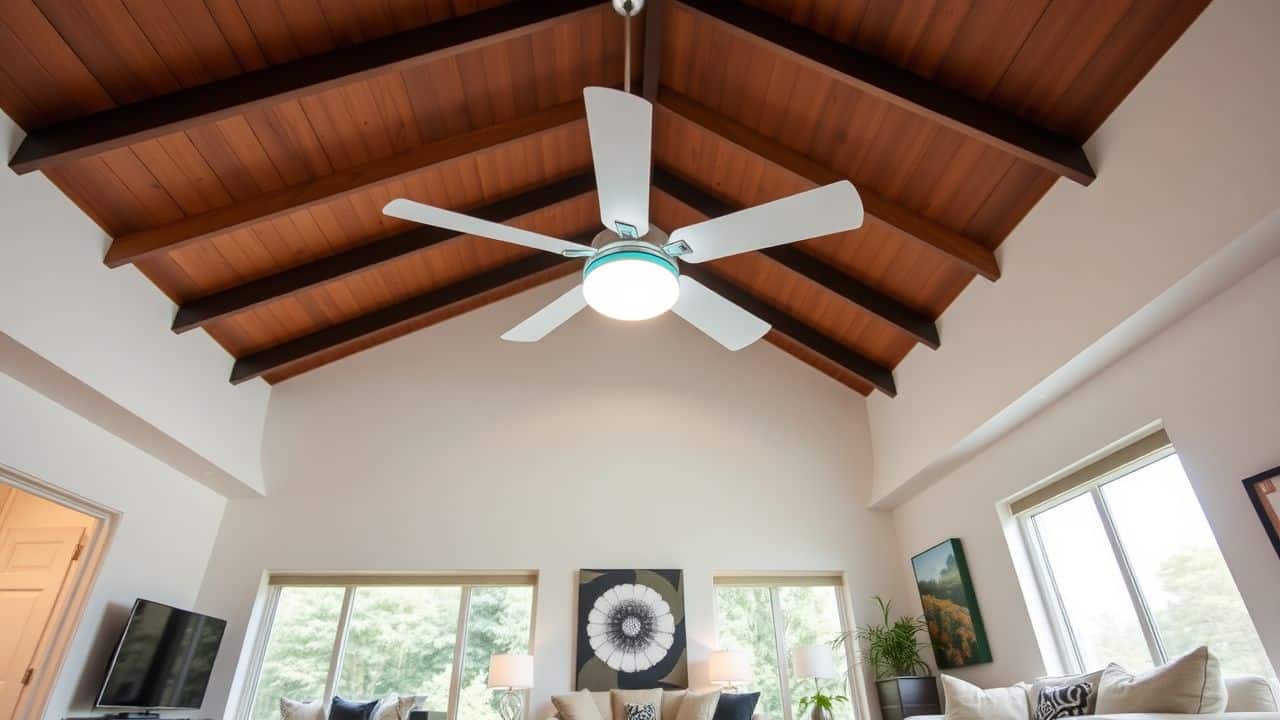
Picking the perfect ceiling fan doesn’t have to be a headache. Start by measuring your room size and ceiling height. These factors will guide you to the right fan width and downrod length.
Next, think about your home’s style. Do you want a fan that blends in or stands out? Modern smart fans offer cool features like Wi-Fi control and LED lighting. But don’t forget the basics – good airflow is key.
Your budget matters too, but so does energy efficiency. ENERGY STAR® fans can save you money in the long run. For outdoor spaces, look for fans rated for damp or wet conditions to avoid corrosion.
And if you have a large room or commercial space, industrial-strength fans might be your best bet. With these tips in mind, you’ll find a fan that keeps you cool and complements your space.
People Also Ask
How do ceiling fans fit into home decor?
Ceiling fans come in various styles, from farmhouse to modern. They’re not just functional; they’re eye-candy too! Pick one that matches your room’s vibe. It’s like putting the cherry on top of your home decor sundae.
Can ceiling fans work with my HVAC system?
You bet! Ceiling fans are like the Robin to your HVAC’s Batman. They help circulate air, making your AC work less hard. This teamwork can lead to lower energy bills. It’s a win-win!
Are smart ceiling fans worth it?
Smart fans are the cool kids on the block. They connect to your Wi-Fi and let you control them with your phone. Imagine changing fan direction without leaving your couch. It’s like having a magic wand for your comfort!
How do ceiling fans affect natural lighting?
Ceiling fans and natural light are best buds. A well-placed fan can help distribute sunlight evenly across a room. It’s like giving your space a natural glow-up without any makeup!
What should I know about ceiling fan maintenance?
Keeping your fan in tip-top shape is a breeze. Regular dusting prevents leaf-like buildup. Check for loose screws now and then. And if you live in a humid area, watch out for corroding. A little TLC goes a long way in keeping your fan spinning happily!
References
https://www.homedepot.com/c/ab/ceiling-fan-buying-guide/9ba683603be9fa5395fab90b9b26067
https://www.rplighting.com/2021/06/01/energy-star-ceiling-fans/
https://cbe.berkeley.edu/wp-content/uploads/2020/04/CBE-Ceiling-Fan-Design-Guide-V0.pdf
https://finchhomesolutions.com/types-of-ceiling-fans-and-how-to-use-them/ (2024-08-12)
https://www.lumarysmart.com/blogs/news-and-blogs/choose-best-smart-ceiling-fan-with-light (2024-10-30)
https://www.thisoldhouse.com/fans/22910890/best-outdoor-ceiling-fan
https://www.ledlightingsupply.com/blog/complete-guide-to-buying-commercial-ceiling-fans
https://www.lowes.com/n/buying-guide/ceiling-fan-buying-guide
https://www.bhg.com/types-of-ceiling-fans-7485246 (2023-04-27)

